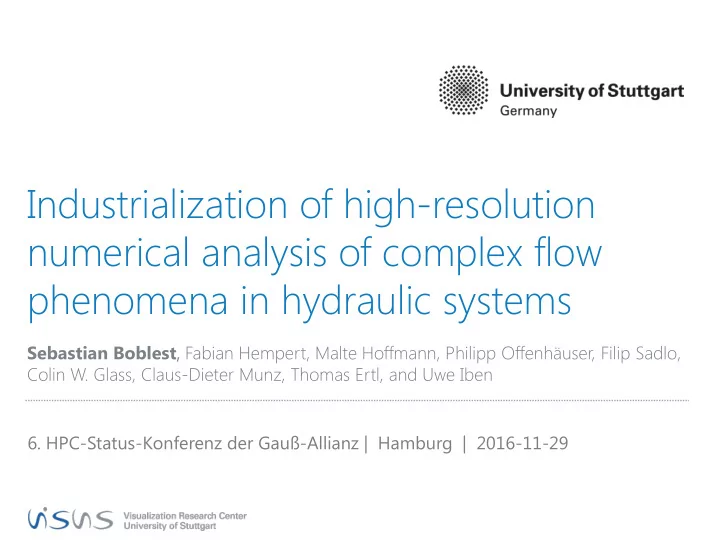

Industrialization of high-resolution numerical analysis of complex flow phenomena in hydraulic systems Sebastian Boblest , Fabian Hempert, Malte Hoffmann, Philipp Offenhäuser, Filip Sadlo, Colin W. Glass, Claus-Dieter Munz, Thomas Ertl, and Uwe Iben 6. HPC-Status-Konferenz der Gauß-Allianz | Hamburg | 2016-11-29
Industrialization of high-resolution numerical analysis of complex flow phenomena in hydraulic systems Adaptation of high-order CFD method for simulations of real gases and cavitating flows High performance and scalability on modern supercomputers Development of postprocessing and visualization tools Application on industrially relevant cases OpenSource publication of code Duration: 01.09.2013-31.12.2016 2
Method Compressible Navier-Stokes-Equations 𝐺 𝑏 𝑉 − 𝛼 ⋅ 𝐺 𝑒 𝑉, 𝛼𝑉 = 0 , 𝑉 = 𝜍, 𝜍 𝜖𝑉 𝜖𝑢 + 𝛼 ⋅ 𝑤, 𝜍𝑓 𝑈 𝐺 𝑏 and 𝐺 𝑒 : advective and diffusive fluxes For application to real gases and cavitating flows: equation of state to compute temperature, pressure and sound velocity 3
Method CFD-Solver based on Discontinuous Galerkin Method Polynomial approximation of solution within each cell Discontinuous across cell boundaries Riemann solver to resolve discontinuity at element interface 4
Discontinuous Galerkin CFD-Solver CFD-Solver based on Discontinuous Galerkin Method. Polynomial approximation of solution within each cell Discontinuous across cell boundaries Riemann solver to resolve discontinuity at element interface Very high parallel scaling due to mostly element local operators 5
Method Unstructured grid with higher-order hexahedrons 𝑂 + 1 3 interpolation points per cell Transformation to reference element [−1,1]³ for calculations 6
Real fluids: Equations of State Ideal gas law: and 𝑞 = 𝜍𝑆𝑈 𝑓 = 𝑑 𝑤 𝑈 Real fluids: Complex Equations of State (EOS) Use data provided by Coolprop library Ideal Gas Real Fluid 7
Real fluids: Equations of State Evaluation of EOS with Coolprop prohibitively slow for simulation Efficient MPI-parallelized pre- evaluation of EOS to a table Quadtree based refinement structure Quadtree structure for table refinement 8
Real fluids: Equations of State Evaluation of tabulated EOSs faster by about a factor 1000 compared to Coolprop Quadtree structure for table refinement e 𝜍 𝜍, 𝑓 → 𝑈 table for water. T color coded. 9
DG Method and Shock Capturing Polynomial DG solution can become unstable Shock waves Phase transitions Underresolved simulations Detection of instabilities with various sensors Program switches to Finite-Volume Scheme in these regions One FV cell per DG interpolation point DG Element FV Subcells 10
Shock Capturing and Load Balancing Computational cost of DG cells and FV cells differs by about 50% Load imbalances Jet Simulation. Top: Persson sensor value, bottom: FV cells. 11
Dynamic Load Change T 0 =0.0ms T 1 =0.25ms T 2 =0.5ms Density Simulation domain (blue) with FV-Subcells (red) DG-FV distribution strongly time-dependent Load balancing must be dynamic 12
Dynamic Load Balancing Strategy Elements are evenly distributed among processors along Hilbert-Curve Effectively 1D Assign different weights to DG and FV cells and distribute weights evenly Cores with many FV cells get fewer cells altogether 13
Load-Dependent Domain Decomposition Reassignment of elements: Shared memory model on node level Each node permanently allocates memory for additional elements All-to-all communication between nodes only of current DG-FV distribution Each core can independently compute new element distribution One-to-one inter-node communication to reassign elements Performance gain ~10% 14
Load-Dependent Domain Decomposition Load distributions on 96 cores before and after load balancing Element distribution on 96 cores after load balancing 15
Dynamic Load balancing: Time-dependent element distribution T 0 =0.0ms T 1 =0.25ms T 2 =0.5ms Currently load balancing applied repeatedly after a fixed number of timesteps Method exploits Hilbert-Curve structure and the relatively small difference in computational cost of DG and FV cells 16
Use Case: Engine Gas Injection Previously: Acoustic Simulation Measured and Natural gas injector simulated sound pressure levels 17
Real Gas Jet Simulation Real gas throttle flow with Methane Inlet pressure: 500 bar, varying outlet pressure Micro throttle with a diameter of D = 0.5 mm Overview of simulation domain. Simulation mesh, high-resolution region in red. 18
Real Gas Jet Simulation Real gas properties of gaseous fluids need to be considered at high pressures Inlet pressure Compressibility factor as a 𝑎 = 𝑞/(𝜍𝑆𝑈) function of pressure for different gases. 19
Real Gas Jet Simulation Flow through throttle subsonic or supersonic, depending on pressure ratio 𝑆 p = 𝑞 in /𝑞 out 20
Influence of Grid Resolution Mixed DG-FV approach can accurately predict major structure of shock locations for all grid resolutions 21
Real Gas Jet Simulation: Mass Flow Analysis Accurate prediction of mass flow is essential to design of gas injectors Dynamic behavior of mass flow at beginning of simulation Interesting because gas injection occurs at high frequencies For 𝑆 p > 2.5 maximum value virtually independent of 𝑆 p 22
Investigation of Single Bubble Collapse Ellipsoidal gas bubble collapsing close to a surface Test case for behavior of solver in cavitating flows Investigation of pressure waves hitting nearby surfaces 23
Investigation of Single Bubble Collapse Spatio-temporal depiction of pressure 𝑞(𝑦, 𝑢) along line. Time Full time resolution, no timesteps omitted Efficient comparison of different simulations Mesh resolution Initial conditions Steep gradients at bubble boundary are challenging for tabular EOS Position on Surface 24
Use Case: Cavitation Evaporation of liquid because pressure drops below vapor pressure High pressure peaks if vapor areas collapse Industrially relevant due to large damage potential in technical devices 25
Cavitation Micro channel flow with water Strong shocks due to caviation DG (5th Order) + FV (2nd Order) Only FV (2nd Order) Mixed DG-FV approach can resolve much finer scales than FV alone 26
Cavitation 27
Conclusion Large portfolio of different fluid dynamic simulations Efficient usage of highly accurate real gas approximations Analysis of the difference between ideal and real gas approximation Mass flow very dynamic for real gas Simulation of cavitation show promising results for high order multi- phase flow 28
Thank you. 29
Recommend
More recommend